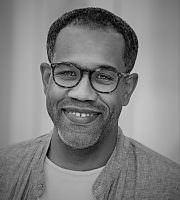by Gregory Pardlo
Lights up, the slow wipe of darkness by an empty swing listing in fog.
The following voice-overs are in the public domain and can be used in both romantic and tragic adaptations:
911 CALLER: It’s probably fake, but you know what, it’s scaring the shit out of me.
911 CALLER: He’s sitting on a swing right now.
DISPATCH: There’s a Black male sitting on a swing.
The child actor pretends not to hear the sirens.
The child actor pretends not to recognize the monologic of the bullet’s one-liner.
Music is diegetic. Narration is diegetic. Everything everywhere is diegetic.
The child actor pretends to play a game. Born for this role, he makes it look real. It is real. Overcast. Light contrasts on the set: sidewalk, grass, gazebo. The audience, remote, watches through a camera hunched like a gargoyle and bolted to the rec center’s façade across the street. The child actor pretends to be a cowboy, reading lines that were not intended for him. The prop, a supporting character, forgets its lines. Bang-bang, the child actor whispers.
This is a live performance.
There are no bad props. Only bad actors. When the fourth wall is blue, bad actors are protected from critical review. When the fourth wall is a flag, bad actors are protected by the Second Amendment.
The Justice Department says the child actor’s prop is “visually virtually indistinguishable” from a real gun.
Bad actors drive their cruiser onto the grass and leap out to prove who has the faster draw. In two seconds flat the child actor gives the performance of a lifetime. Justice is not the critical rubric for this tragedy. The video will not do it justice. Justice will not be done.
For contrast, refer to the October 21, 2021, adaptation staged at Bonanza Creek Ranch in Bonanza City, New Mexico, featuring the bullet in a tragicomic performance.
Fade in: dusty saloon doors weep rusty in the wind.
Set the cinematographer behind her camera to line up her shot. The bad actor aims his prop gun at her and pretends to shoot. His face is pained with laughter. The bullet appears, confused, to everyone’s surpise, in the wrong scene, on the wrong set.
The bad actor shoots the cinematographer before she shoots him. This is a Western. The fastest actor wins. This is an actor-involved shooting.
The weight of a watch battery, the bullet has no wardrobe requirements. It brings its own metal jacket.
Supplement:
The seminal American performance took place at the opera house in Livermore, Kentucky, 1911. Staging the show for themselves, the audience kindled the footlights for effect and tied the lifeless body of their lead actor to the existing set onstage. The lead role of Will Potter, a Black man accused of attempting to murder a white man who had instigated a poolroom brawl, was played by himself. The lead role is a prop. The audience propped up Will Potter like a marionette without strings, and, from the orchestra pit, let their instruments resound. Bullets took to the air like notes lifted from sheet music, making a percussive accompaniment to Will Potter’s finale. The music was diegetic, though it could have been mistaken for thunderous applause. The audience threw roses. The roses, too, were bullets.
Last updated August 05, 2025




